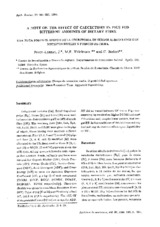A note on the effect of caecectomy in pigs fed different amounts of dietary fibre
Una nota sobre el efecto de la cecectomía en cerdos alimentados con distintos niveles y fuentes de fibra
Autor
Pérez Lanzac, J.
Bodart, C.
Thielmans, M.F.
Editor
Universidad de Córdoba, Servicio de PublicacionesFecha
1990Materia
Tiempo de retención mediaAlimentación animal
METS:
Mostrar el registro METSPREMIS:
Mostrar el registro PREMISMetadatos
Mostrar el registro completo del ítemResumen
Dehydrated Lucerne (Lu), Dried Sugarbeet pulps (Bp), Straw (St) and Oats (Ot) were used to formulate diets containing 5% or 10% of crude fibre (CF). The resulting diets (Ot5, Lu5, Bp5, St5, Lu10, Bp10, and StlO) were given to 14 pigs of which, those having even numbers suffered caecectomy. Four (1, 3, 5 and 7) normal (N) pigs and four (2, 4, 6, and 8) modified (M) were allocated to the 5% diets; another three N (9, 11 and 13) or M (10, 12 and 14) pigs were given the 10% diets. All pig-groups followed a latin-square diet rotation. Feeds, reffusals and feces were assayed for Organic Matter (OM), Crude Protein (CP); Fibres: Crude (CF), Neutro-Detergent (NDF), Acid-Detergent (ADF); and Gross Energy (GE) to asses the Apparent Digestion Coefficient (DC, g x kg-1) of each component (DCOM, DCCP, DCCF, DCMDF, DCADF, DCHCELL, DCGE respectivelly). Chromiun dioxide was given to asses Mean Retention Time (RT). Type of pig (N or M) significatively affect RT, (30,8 vs 27,3 h respectively). The 10% CF diets presented lower DC values except for ADF. Recibido: 11-1-90. Aceptado: 15-5-90. RT did no varied between CF levels. Pigs consumming Bp resulted on higher D COM and most F fractions and, despite lower intakes, had longer RT. In the conditions of this trial caecectomy had not any deleterious effect upon digestibilty or RT. Se utilizó alfalfa deshidratada (Lu), pulpa de remolacha deshidratada (Bp), paja de cereal (St), y avena (Ot), para formular dietas con el 5% o 10% de fibra bruta. Los piensos resultantes (Ot5, Lu5, BpS, St5, LulO, BplO y St10) se distribuyeron a 14 cerdos de los cuales, los que tenían numeración par, sufrieron cecectomía. Cuatro (1, 3, 5 y 7) cerdos normales (N) y cuatro (2, 4, 6 y 8) modificados (M) consumieron los piensos con el 5% mientras que otros tres N (9, 11 y 13) o M (10, 12 y 14) recibieron los del 10% de fibra bruta, realizándose en cada caso una rotación en cuadrado latino. Los piensos rehusados y heces se analizaron para Sustancia orgánica (OM), Proteína bruta (CP); Fibras bruta (CF), neutro-detergente (NDF), ácido-detergente (ADF) y energía bruta (GE); para determinar el coeficiente de digestiblidad aparente (DC, g x kg-1) de cada componente (DCOM, DCCP, DCCF, DCMDF, DCADF, DCHCELL y DCGE respectivamente). Se distribuyó óxido de cromio para determinar el tiempo medio de retención (RT). El tipo de cerdo (N o M) afectó al RT, significativamente (30,8 vs 27,3 h respectivamente). Los piensos con el 10% de CF tuvieron DC más bajos excepto para FAD. El RT no varió entre niveles de F. Los cerdos que consumieron Bp tuvieron un DCOM, así como de la mayoría de las fracciones de fibra, más elevado, y, a pesar de las más bajas ingestiones, manifestaron un RT más largo. En las condiciones de este experimento la cecectomía no tiene efecto negativo sobre la digestibilidad o RT.

